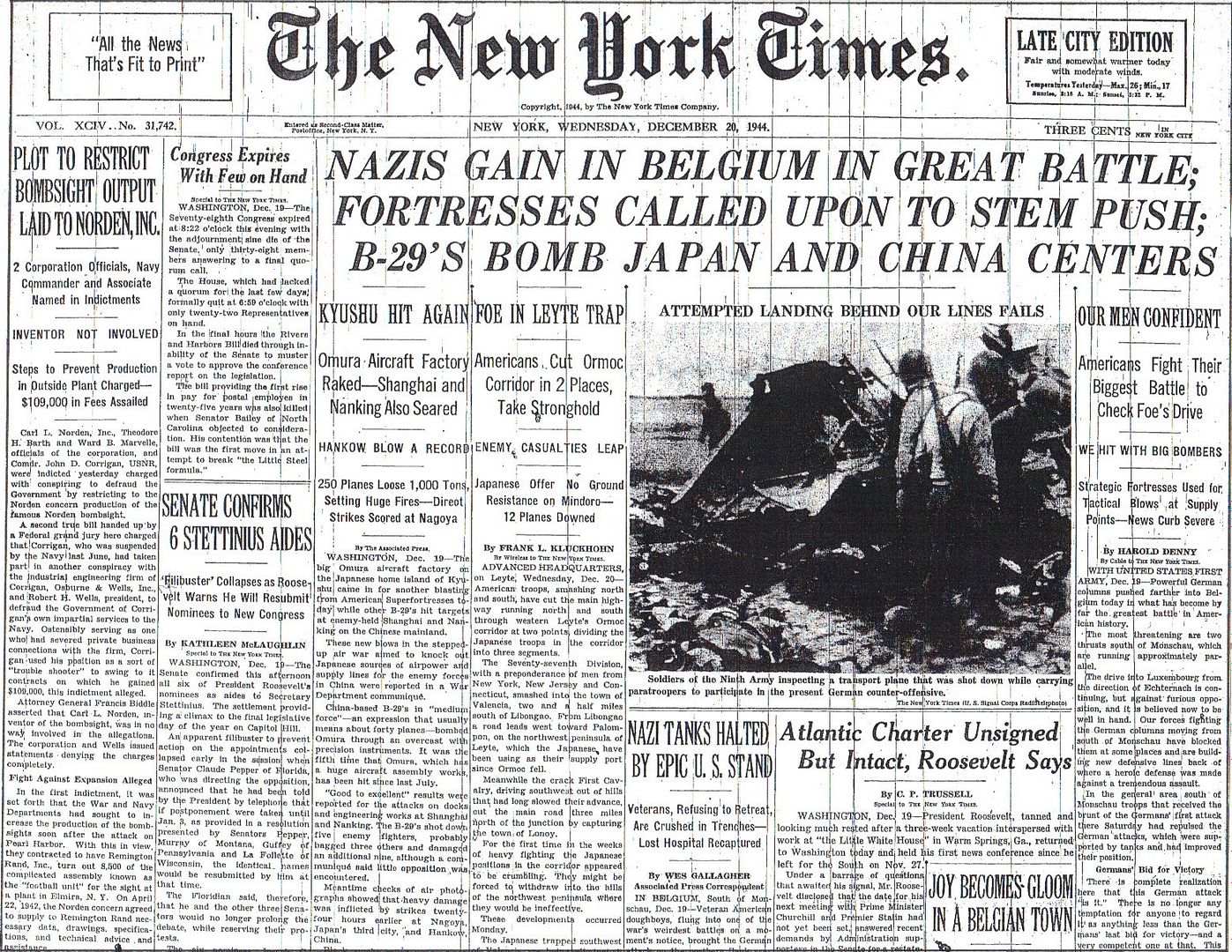
Posted on 12/20/2014 4:18:22 AM PST by Homer_J_Simpson

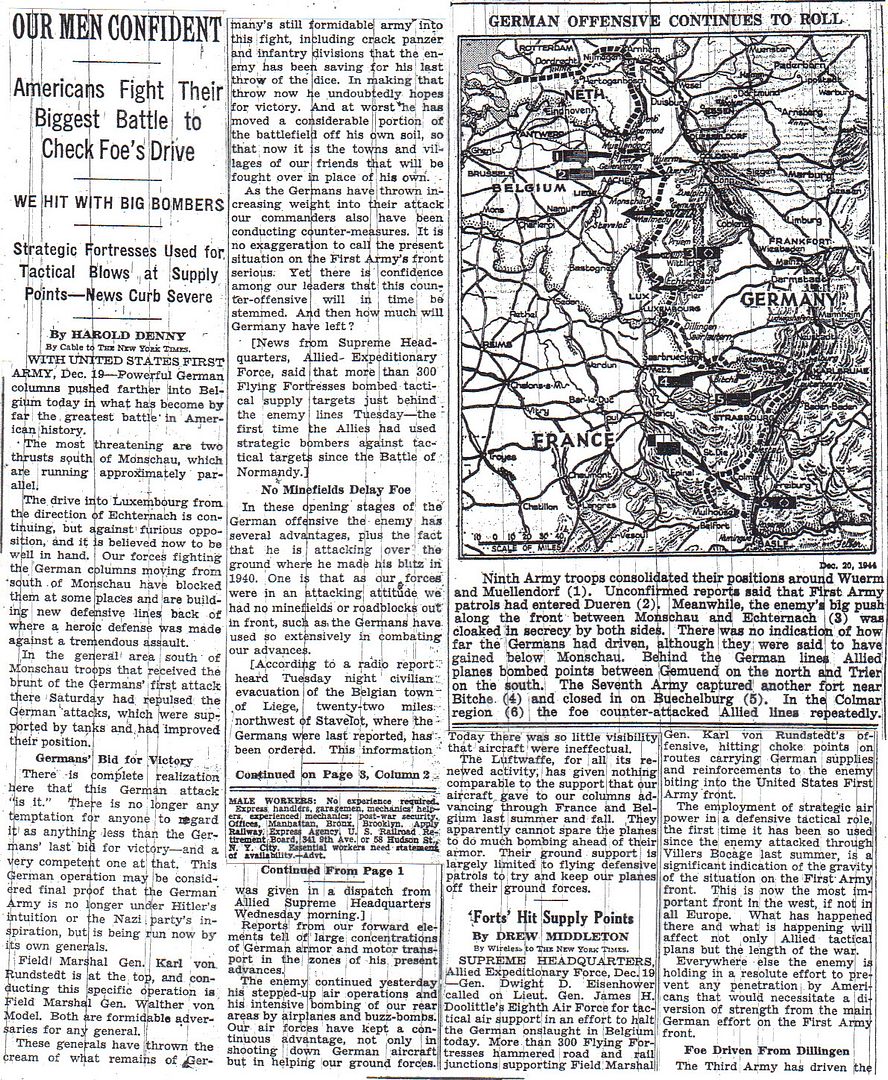
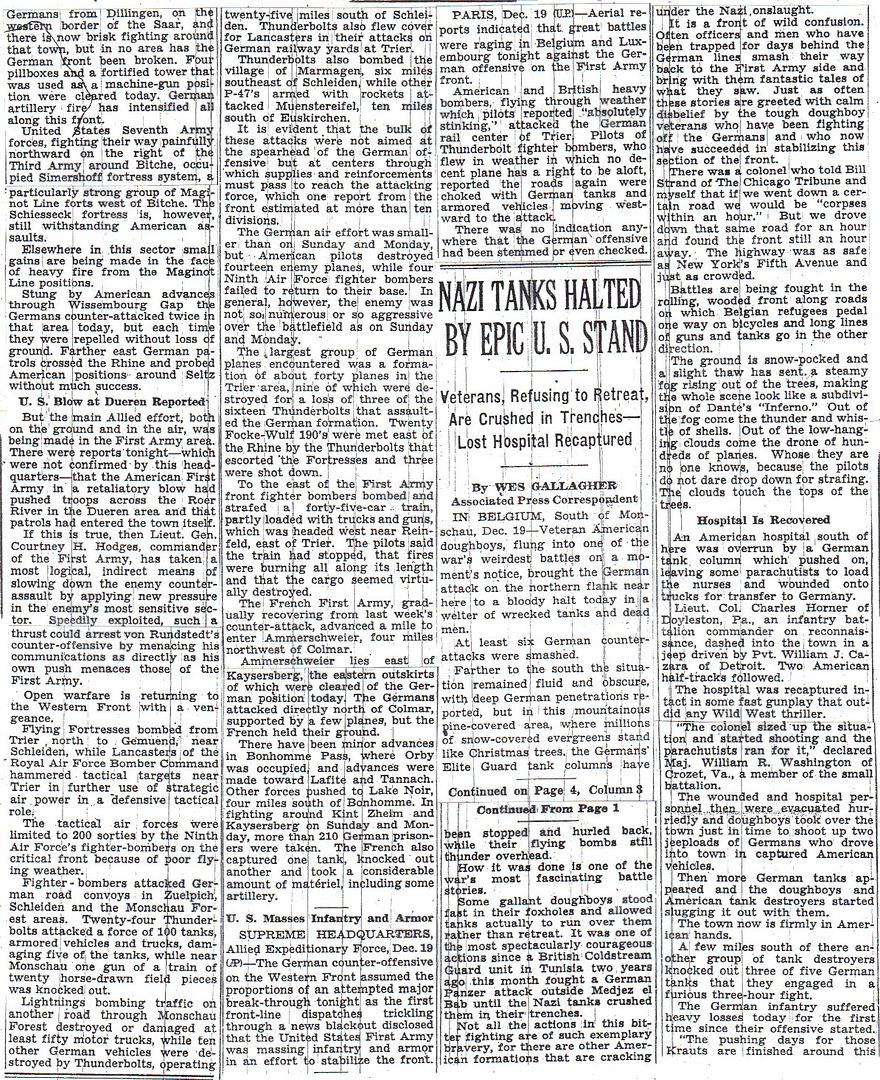
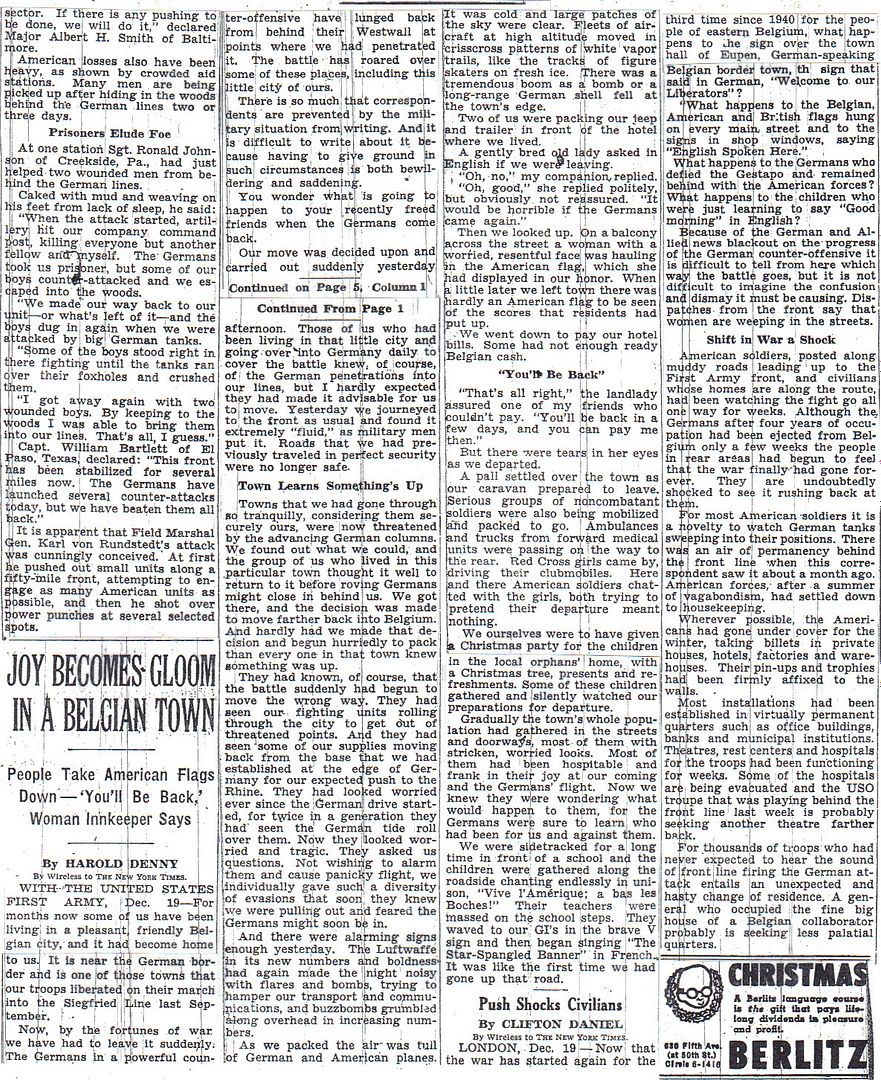
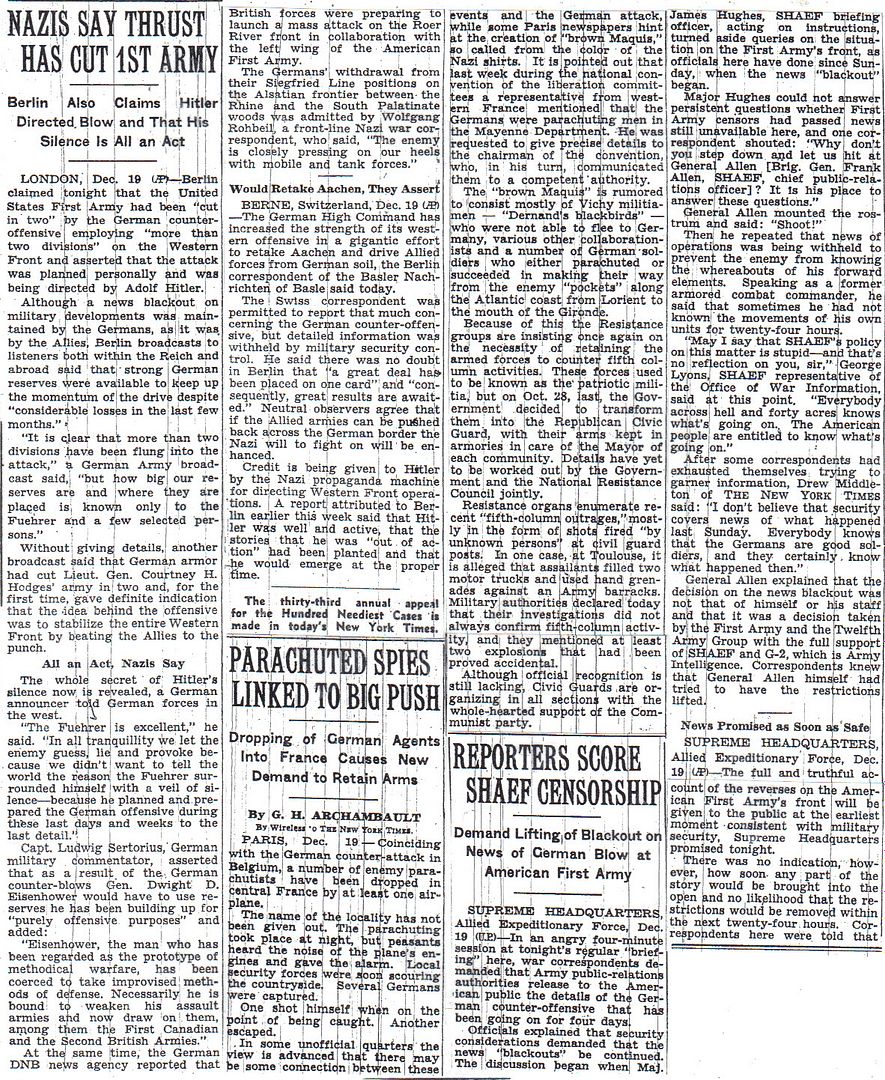
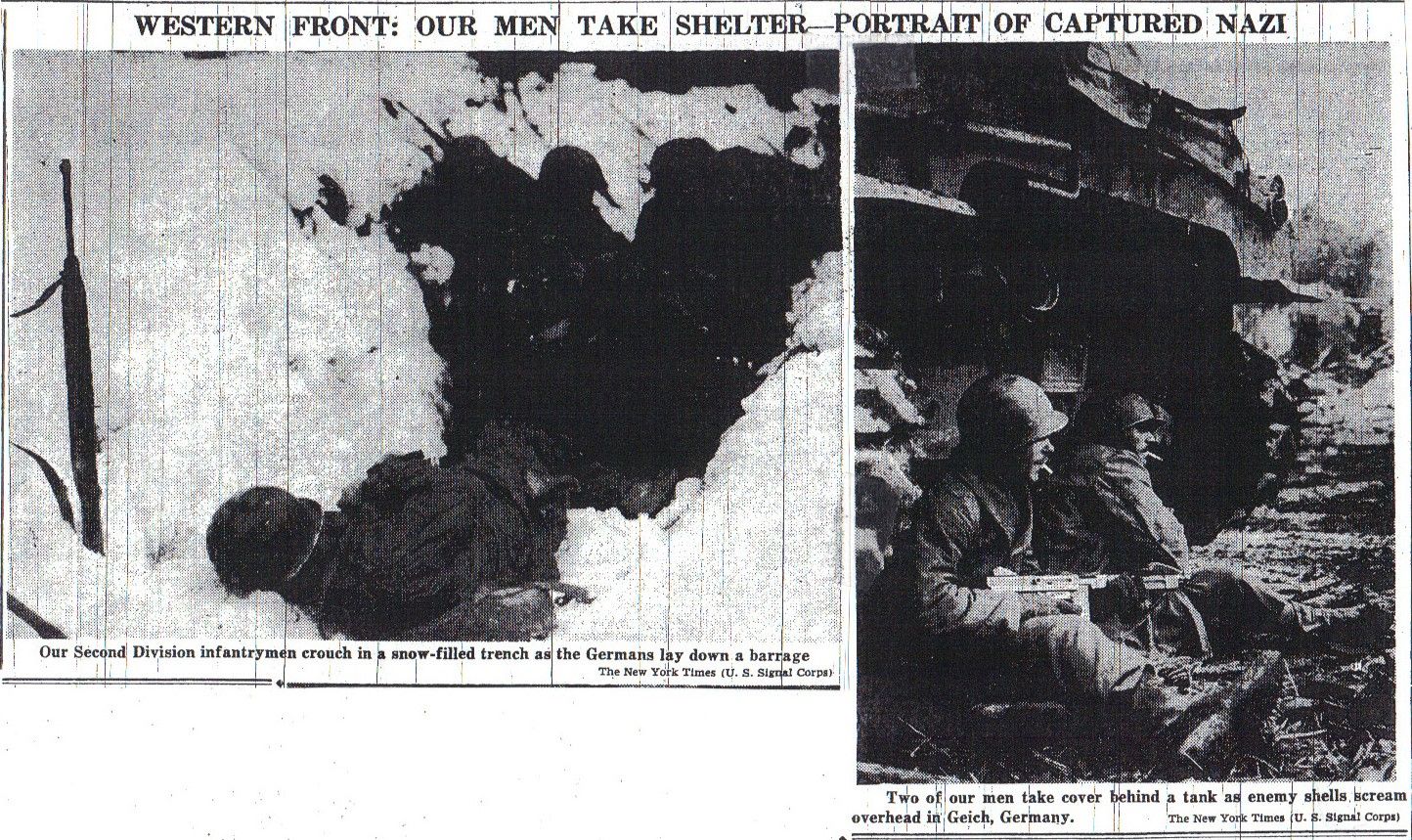
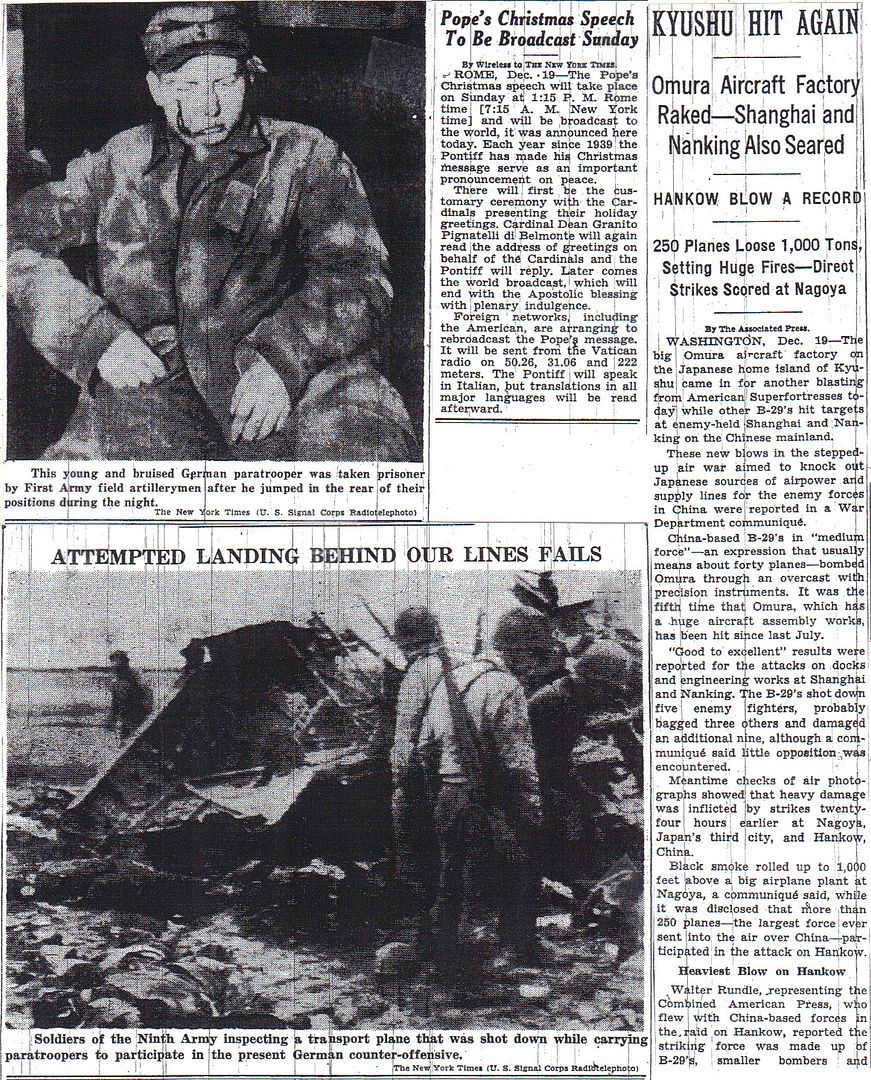
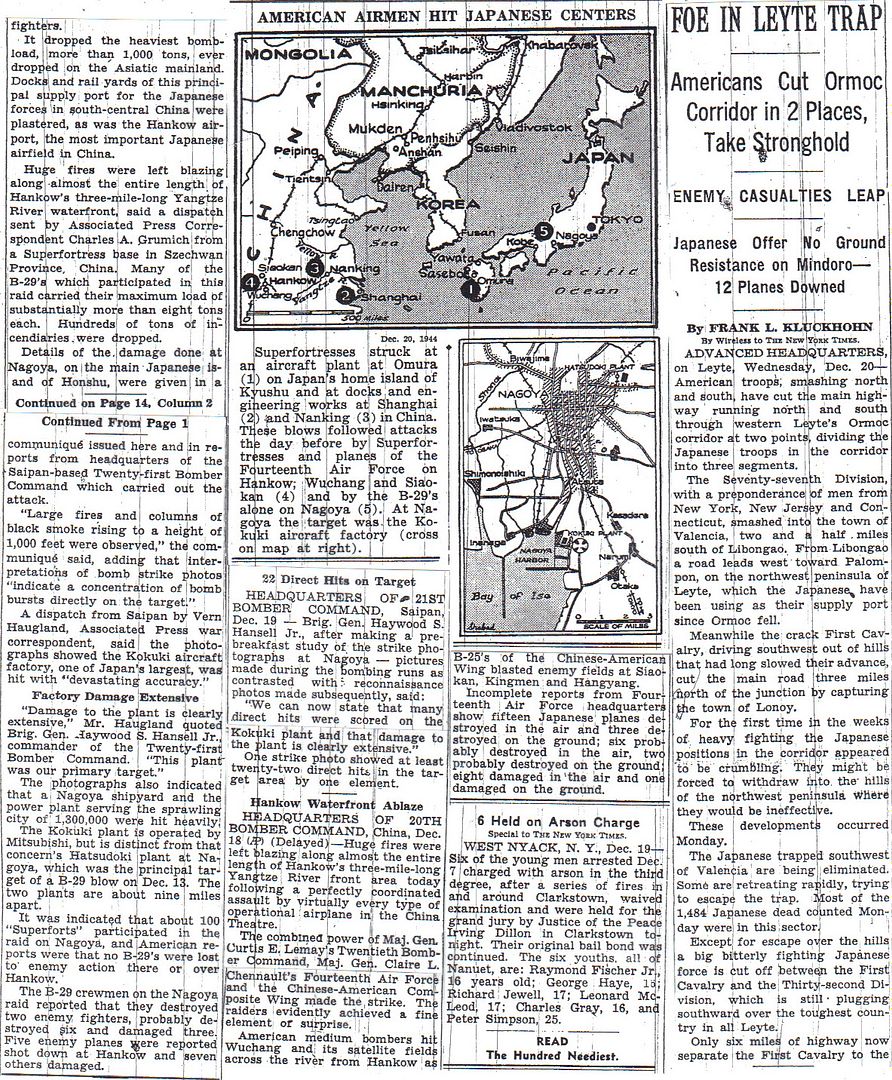
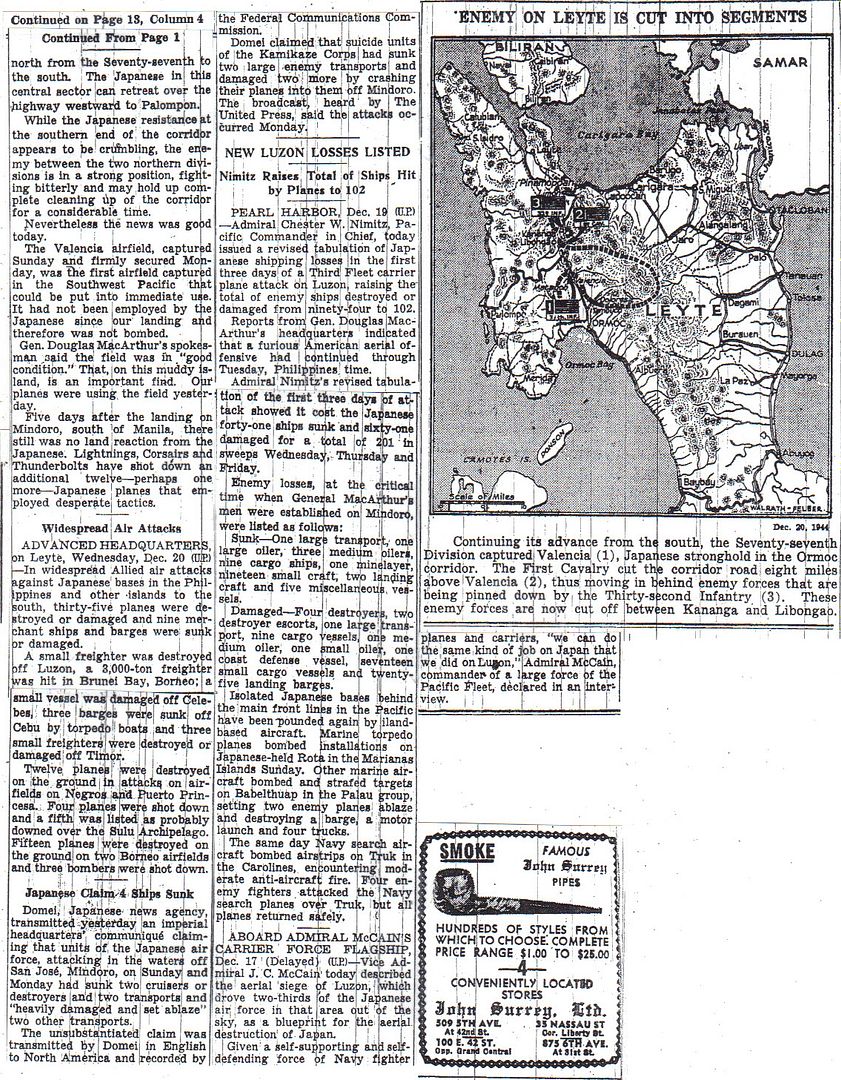
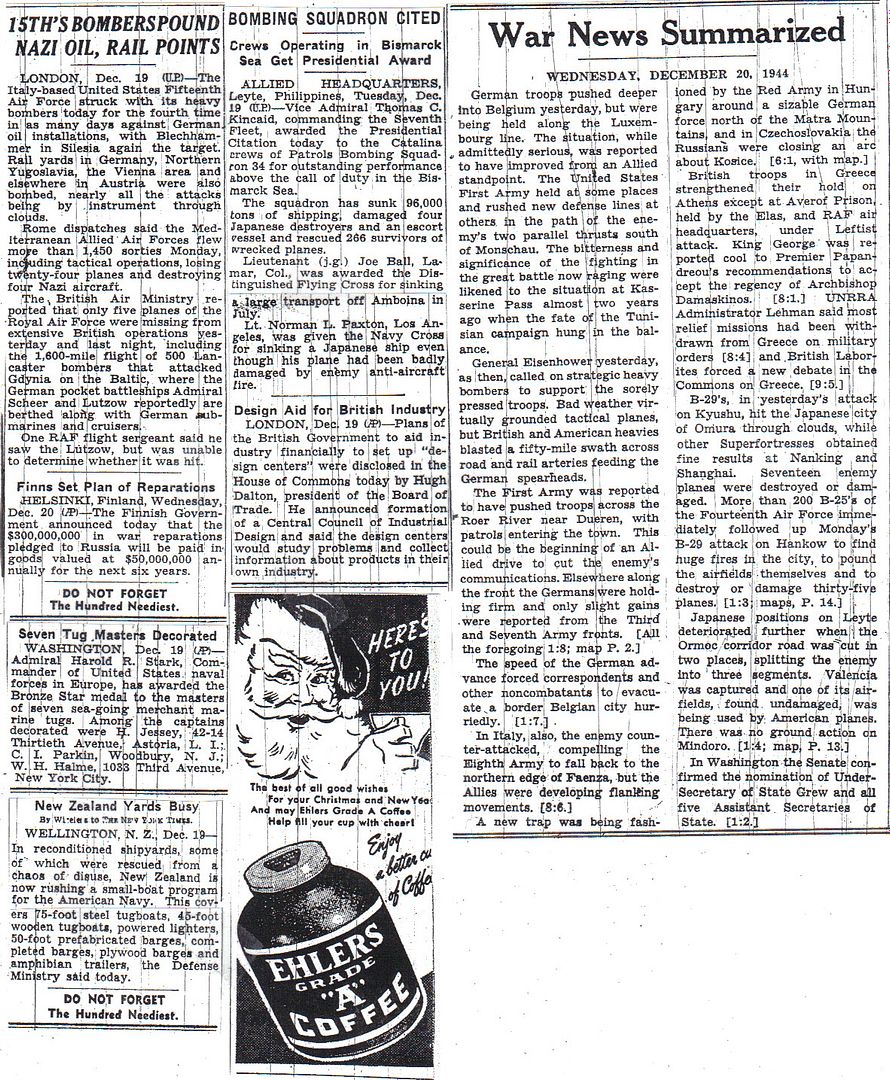
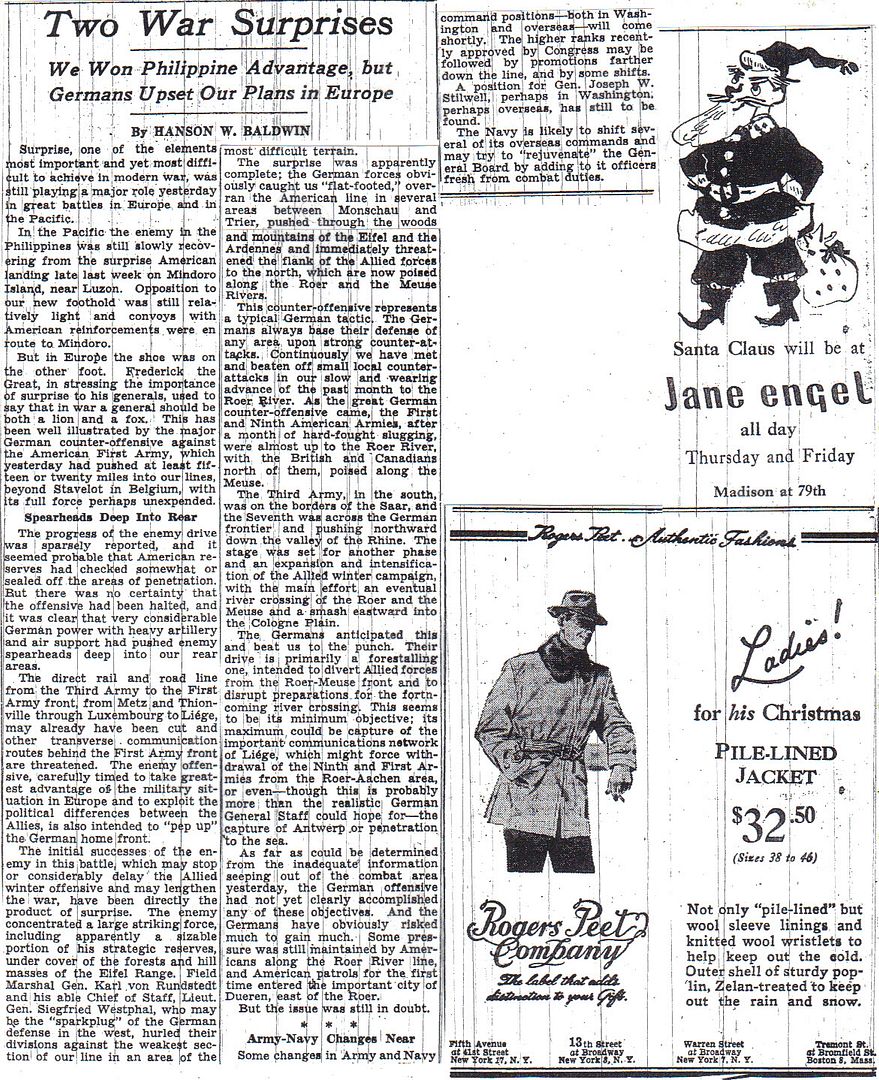

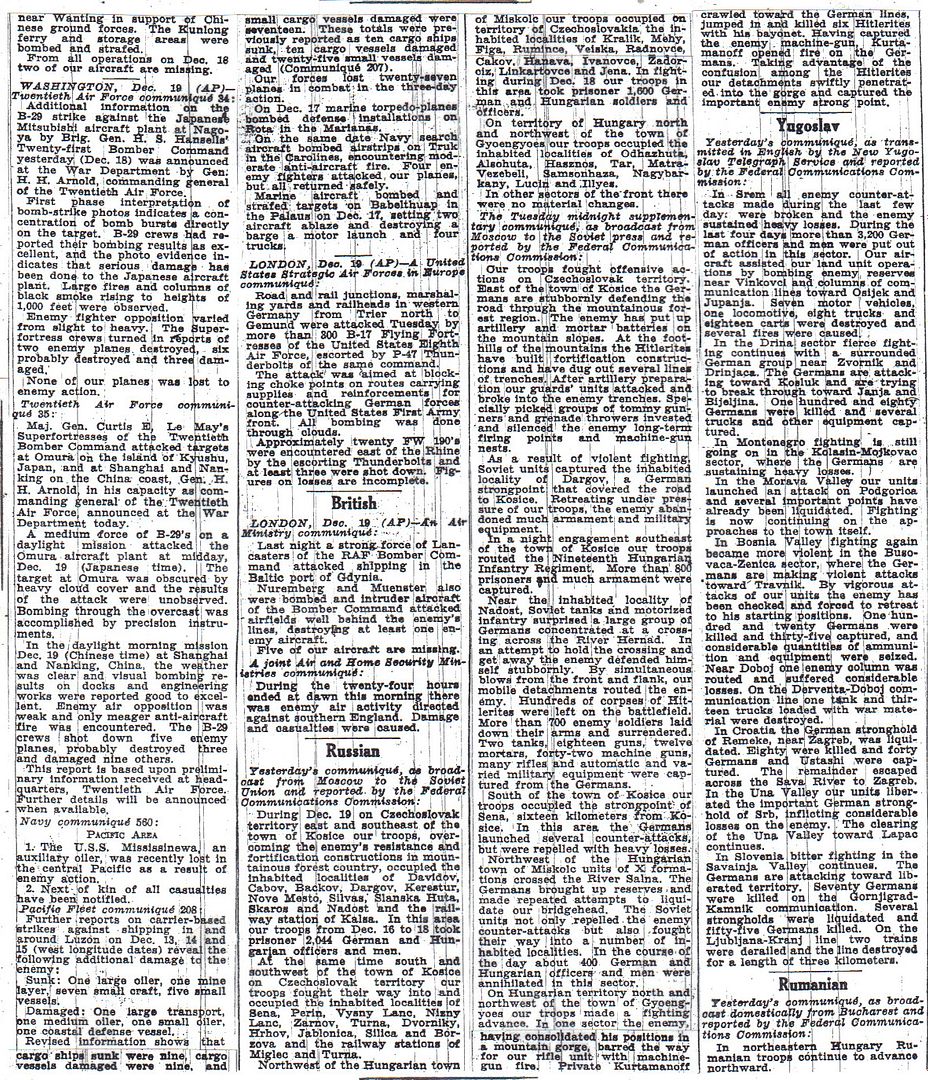
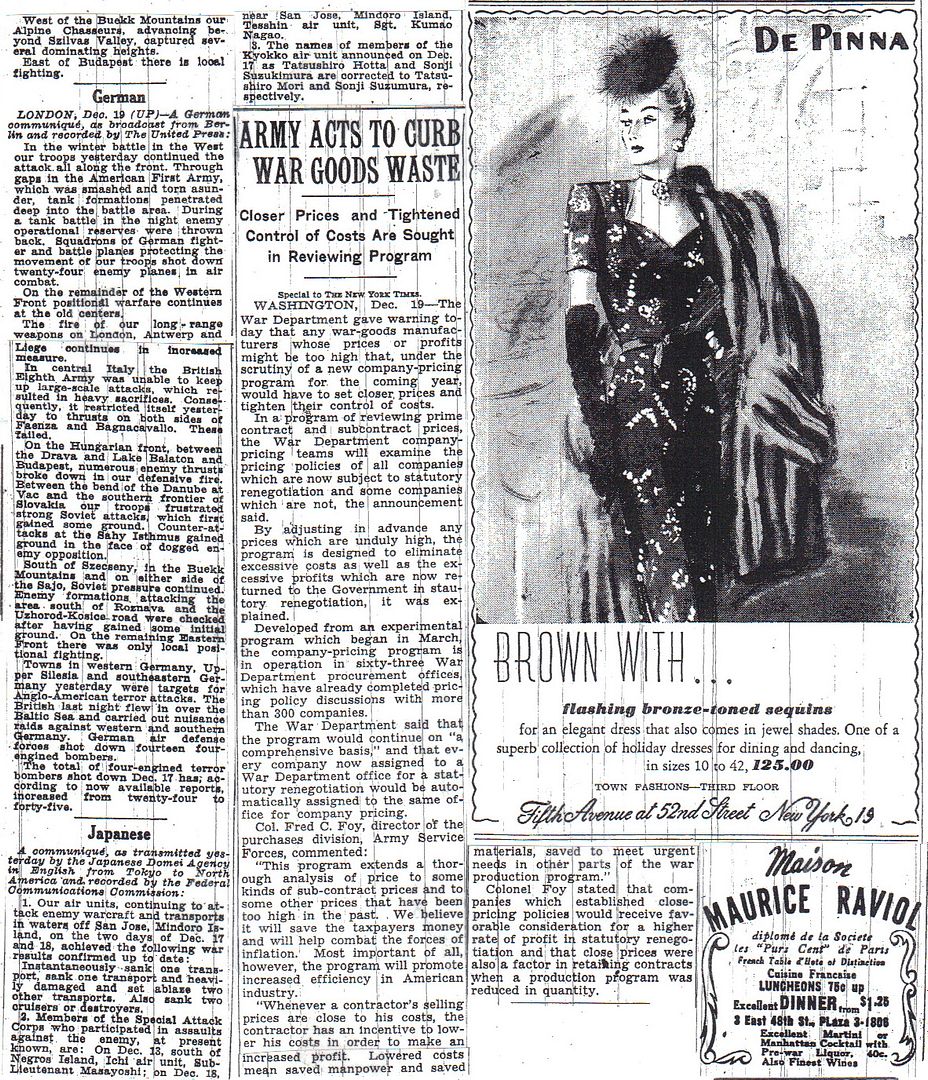
The onwar.com chronology has not been working since Thursday.
http://www.etherit.co.uk/month/11/20.htm
December 20th, 1944 (TUESDAY)
UNITED KINGDOM: Frigates HMCS Saint John, Stormont, Port Colborne, Nene, Loch Alvie and Monnow arrived Clyde with Convoy RA-62.
WESTERN EUROPE: Weather grounds the USAAF Ninth Air Force bombers. Fighters fly armed reconnaissance in western Germany, escort RAF Lancasters, fly patrols from Belgium to the Rhine River, support the U.S. 1st, 2d, 99th, and 106th Infantry Divisions, and 7th Armored Division (north and east of Malmedy, Belgium, and southeast and southwest of Saint-Vith, Belgium), and fly cover for U.S. Twelfth Army troops and the XII Corps near Verdun and Saint- Avold, France.
EIRE: An RAF Catalina Mk. IV assigned to No. 202 Squadron, RAF Coastal Command based at RAF Castle Archdale, County Fermanagh, Northern Ireland, crashes on Stradbally Mountain, County Kerry. The wreckage is finally removed in 1978.
NORWAY: German submarine U-737 is sunk in the Vestfjorden about 61 nautical miles (112 kilometers) north-northeast of Bodo¸, after a collision with MRS 25; 20 of the 51 crewmen survive.
BELGIUM: Because of the German Ardennes counteroffensive, Field Marshal Bernard Montgomery, Commander in Chief 21st Army Group, abandons a plan to employ XXX Corps, British Second Army, in the Nijmegen, The Netherlands, area and orders it to assemble in the Louvain-St Trond-Hasselt region to hold the Meuse River line.
German forces attack north from the area of Stavelot but are forced back. St. Vith and Bastogne are still held. The road junctions of these towns are vital to the German offensive.
As German troops encircle the US 101st Airborne and 9th and 10th Armoured Divisions at Bastogne, the Allies impose a blackout on all news from the Ardennes fighting, which is now being called the “Battle of the Bulge.”
General der Infanterie Heinz Kokott, Commanding General 26 Volks Grenadier Division:
“. . . division, during the early hours of 20 December, had issued issued its orders to the regiments.
“For Regiments 77 and 78 these orders called for a continuation of their attack . . . as had been planned and ordered for the previous day.
“Regiment 78 had the additional mission to clear, before the start of the attack, the situation at Margeret as some enemy nests were still holding out in the southern part of the village. . . . and positive contact was to be established with the Panzer Lehr Division fighting near Neffe.
“The main point of effort of the division attack was to be, as heretofore, in front of the (left) Regiment 78. The terrain (affording a good view for observation) as well as the intention to get hold of as quickly as possible of the dominating heights west of Bizory, were the decisive factors for selecting this sector as the central point of effort.
“The main attack was to begin as soon as the customary morning fog would have lifted sufficiently to safeguard a clearly observed support by infantry and heavy weapons.
The morning fog was, of course, supplied by nature. The fog of war would be supplied by elements of the 101st Airborne.
“Towards 0700 hours on 20 December, Grenadier Regiment 78 reported that Margaret was “enemy free” [those words again] and that combat fit reconnaissance troops were on their way to the west.
Grenadier regiment 77 reported regroupings during the assembly. It was a very foggy day and at first all observation was impossible.
“Between 0900 and 1000 hours, 20 December, the commander of XLVIII Panzer Corps appears at the division command post. He pictured the situation as follows:
“The 2nd Panzer Division has taken Noville. The enemy is in flight-like retreat from the 2nd Panzer Division via Foy to the south. The 2nd Panzer Division is in steady pursuit. The fall of Foy - if not already taken place - is to be expected at any moment. After the capture of Foy, the 2nd Panzer Division, according to orders, turns to the west and drives into open the terrain.”
The corps commander, General der Panzertruppen Heinrich Freiherr von Luettwitz, has got it wrong. Perhaps the commander of the 2nd Panzer Division, Colonel Meinrad von Lauchert, has been sending “anticipatory” reports to corps. The facts are that Team Desobry and the 1st Battalion, 506th did not withdraw from Noville until 1330 hours. The order for the withdrawal came down on the Field Artillery
FO radio and I passed it to the battalion commander. (See S.L.A. Marshall; Bastogne, The First Eight Days.) Luettwitz speaks of “The fall of Foy.” (It sounds almost like “the fall of Paris.”) At the time Foy was a collection of four or five farms. It was on low ground and could not be defended. The road from Noville to Foy ran downhill for 1.8 kilometres and then toward high ground for 200 meters. On that high ground the 2nd and 3rd Battalions of the 506 had established defensive positions through which we moved into a reserve position. This was not a text book retrograde but we were hardly in “flight-like retreat” and the 2nd Panzer was not coming down that road in pursuit. I think that they were happy to be rid of us so that they could continue the drive west to the Meuse. We had done them great harm.
At the time the Noville-Foy-Bastogne road was the right boundary of the 506th. About 200 meters east of the road was Bois Jacques.
During a period of 30 minutes approximately 50 German soldiers came out of the woods with their hands over their head and surrendered to us. I believe that they were members of the 26th VG Division, probably of Regiment 77 of that division. So much for high morale in that division.
“It is now the primary mission of the 26th Division with all its available elements to proceed via Wardin - Remoifosse for an encirclement of Bastogne from the south, then to penetrate Bastogne from the soutwest and to intercept the enemy in his withdrawal and breakthrough to the southwest or west. The Panzer Lehr Division, with main effort on the left near Marvie, will close in on Bastogne from the southeast.
“This unfortunate change in the situation came as a surprise to the division; all the more so since Regiments 77 and 78 had not detected or reported any signs of weakening on the part of the enemy.
They only had to record unchanged heavy enemy resistance and powerful artillery - and mortar fire. The same impressions had continuously been reported by the Reconnaissance Battalion 26 which was facing the enemy.
“On the basis of this orientation and instructions through the Panzer corps, the division now immediately turned its individual orders to the Regiments, utilizing all available means of communications. “
XLVII Panzer Corps had ordered the 26th VG to send its Regiment 39, which had been guarding the left flank of both the division and corps, on a wide swing south of Bastogne to almost due west of the city while the 26th Reconnaissance Battalion would do the same and take up positions to the southwest of Bastogne. Between these two major elements of the 26th VG and its Regiments 77 and 78, corps would insert the Panzer Lehr Division to which the 77th and 78th would be attached.
Kokott called meeting of the commanders of Regiment 39 and all separate battalions of the division in Wardin.where the division command post was located. He brifed them on the division’s mission of attacking and entering Bastogne from the southwest and west.
During this meeting an officer who had recconnoitered the routes to the west reported that the road were impassable for vehicles. The vehicles, which contained much ammunition and equipment, would have to make a long detour to the east in order to get to their new positions in the southwest and west. This would cause an inordinate delay. Kokott ordered that the vehicles be unloaded and that the men carry as much of this load as possible.
“The commanders reiterated their respective missions. Everything was clear. The rifle companies and the engineers company which had arrived in the meantime, unloaded their combat vehicles without delay. The staff of the First Battalion of Rifle Regiment 39 and parts of the regimental staff were moving up, additional units of the Replacement Training Battalion, engineers, and the Second Battalion of Rifle Regiment 39 followed. As they were approaching, they remained in the march and - after the equipment had been taken off the vehicles - disappeared in “single file”, loaded down heavily with weapons and ammunition, in the forest heading for Lutrebois. With exemplary calm and matter-of-factedness, weapons, ammunition and equipment were unloaded, stripped and picked up, with the stead flow of the arriving units continuing to the west and southwest.”
“. . . the division commander was getting ready for his drive ahead [to the new area of operations in the west and southwest] via Doncols - Lutremange to Remoifosse when an artillery salvo - about 12 shots - landed straight in the center of Wardin [the division CP]. This was not particularly alarming until there was, shortly thereafter, another battalion salvo - this time at the western edge of the village - which broke the windows of the command car. Orders had just been issued to disperse the motor vehicles further and all drivers were busy with theri machines and motors - when the third time the dull drumming of fire and became audible and already the impact of the batteries hitting - this time straight into the assembled motor; this was immediately followed for several minutes by a fire concentration with devastating effects on this assembly of men and machines.
“The fire ceased. The enemy observers - and this could only have been an observed fire - appeared to be satisfied with their success. “And they had reason to be satisfied. The command staff was considerably paralyzed. The vehicles, including the command car, were burning or had been knocked out of commission, a great number of men and almost all the officers had either been killed or wounded, among them the first liaison officer, the division intelligence officer (Ic), two officers of the Signal Battalion, one engineer officer and one liaison officer. The Ia (operations officer) and Iia (officer personnel officer) - same as the division commander - had only been slightly wounded.
“This occurred towards about 1300 hours. “It was fortunate that all the necessary orders had been given before and that all movements had already been started. “The dead were laid out, the wounded were bandaged. From the command post of Artillery Regiment 26 - located in a house in the village and thus slecetd somewhat more appropriately - the command of the battle was taken over again and the command staff somewhat restored.”
I doubt that this was an observed fire mission. In all probability information had been received that the 26th VG had its CP there and the location was fired upon as an unobserved fire mission. There was no place for observers to be located. I would like to believe that this mission had been fired by my battalion, the 321 Glider Field Artillery but we were engaged in the north and northeast in support of the 506th. Wardin was opposite the zone of the 501st which had the 907th Glider Field Artillery in direct support. So the mission was fired either by the 907 or one of the 155mm corps artillery battalions attached to the division. It is gratifying, however, to read how artillery can mess up a division headquarters.
“Towards 1430 hours a message arrived from Rifle Regiment 39 to the effect ‘that the forward elements of the regiment, after having crossed the north-south highway (Bastogne - Mortelange) had become engaged with enemy forces.” [This was either the 327th Glider Infantry or the 326th Airborne Engineer Battalion.]
“Dusk and darkness arrived very early on that winter day. From Doncols on the road necame poor, muddy, at some parts very narrow and there were many slopes. This, however, was the least. A lot more disagreeable was the fact that - in contrast with the exemplary traffic movements in the morning - now there presented itself a picture of considerable confusion; everything was crowding onto this road: tanks of the Panzer Lehr Division, so broad that they could barely squeeze through defiles and villages; trucks which had skidded off or had become stuck; motorized vehicles of an advance section of the 5th Parachute Infantry Division, supply vehicles, and motorcycles; marching in between or pushed to the side or came to a standstill due to exhaustion were the horse-drawn vehicles of the 26th Division which had again been overtaken by the companies on foot of the 5th parachute Infantry Division, with the men themselves pulling their vehicles. In addition - ambulances, damaged tanks and captured tanks driving back from the west! . . . traffic came to a standstill and became almost hopelessly entangled!”
Kokott goes on to discuss a lack of training and discipline. The result of this hampered operations around Bastogne and in the withdrawal from the Ardennes.
“These road conditions reached their peak later when SS-formations arrived in the Bastogne combat sector. These units - unduly boastful and arrogant anyway - with their total lack of discipline so typical for them, their well-known unreserved ruthlessness, paired with a considerable lack of reason, had a downright devastating effect and in all cases proved a handicap for any systematic conduct of fighting.”
“. . . the division commander reached the [new] command post at Bras only after midnight, i.e. towards 0100 on 21 December. Based on incoming reports, the situation to him on that night appeared as follows:”
“The Grenadier Regiments 77 and 78, while fighting some very costly battles, had made but small progress. “The heavily defended village of Bizory, however, had been taken by Grenadier regiment 78.
“The regiments were now located immediately west of the Foy - Bizory road. Enemy resistance there: strong.” “The enemy forces opposite Rifle Regiment 39 fought stubbornly and were supported by tank (guns)?, artillery and, particularly, by strong mortar fire.
This was the 327th Glider Infantry Regiment which would defend 50% of the circle around Bastogne.
“As to the impression of the enemy, it appeared that - even if he would put up a stubborn and tough battle - he would be less strong and prepared in the southern sector than in the eastern sector.
(Kokott probably received this impression from the fact that the 501st had handled his division roughly and no other units would be as severe with them.)
“Here in the south - and perhaps in the west - the success had to be aimed for and to be fought for with all the strength!”
At the end of the day, 5th Panzer Army described the organization for combat of the units to be involved in the reduction of Bastogne. Essentially they were the divisions already involved.
“The division dutifully expressed its doubts and considered the chances for success under existing conditions unlikely. These doubts were eliminated, however, by the corps in its estimate of the enemy situation, which was about as follows: ‘There are certain indications that the enemy had already become softened. Furthermore it could be assumed that there could ‘not be much inside’ Bastogne. Aside of parts of an airborne division, which, however, could not be very strong, it was reckoned that there would be the remnants of those enemy divisions, which had been abdly battered at the Our River and which ahd taken refuge in Bastogne. On the strength of prisoner of war interviews, the fighting quality of the forces inside of Bastogne was estimated not to be very high.’”
“The losses on 20 December for the division mounted to about: 8 - 10 officers and 300 men killed, wounded and missing. Most of this was suffered by Rifle Regiment 39 and Grenadier Regiment 78.”
So ended another tough day for General Heinz Kokott. But that’s what they pay division commanders for.
First Lieutenant Francis Canham, 321st Glider Field Artillery, was killed in action in Noville, Belgium observing fire on the 2nd Panzer Division.
(Jay Stone)
LUXEMBOURG: The U.S. Third Army forms a provisional corps from former First Army units south of the Ardennes salient, the 4th Infantry Division and the 10th Armored Division (- Combat Command B); the corps is to hold the Germans on the south flank of the penetration and plug a gap existing between it and elements of the 9th Armored Division and 28th Infantry Division near Ettelbruck.
FRANCE: Patton starts moving his 250,000 strong army from the Saar to the Ardennes.
The US 100th Infantry Division completes the capture of Fort Schiesseck. The fortress is 14 storeys deep, complete with disappearing gun turrets and 12-foot thick steel-reinforced concrete walls. (William L. Howard)
Allied commanders conferring at Verdun decide to halt offensives toward the Rhine and concentrate on reducing enemy salient in the Ardennes. General Dwight D. Eisenhower, Supreme Allied Commander of the Allied Expeditionary Force, studies the situation map in his office and draws a line from Givet, France, on the Muese River through the Ardennes and across the German frontier to Prum. All Allied units north of the line are placed under command of British Field Marshal Bernard Montgomery, Commander in Chief 21st Army Group, which means that he commands the U.S. First and Ninth Armies. South of the line Lieutenant General Omar Bradley, Commander in Chief 12th Army Group, would command the U.S. Third Army. He ordered that the change take effect on 1200 hours on 20 December. (John Nicholas and Jay Stone)
The U.S. Seventh Army is ordered to go on the defensive. In the XV Corps area, the 44th Infantry Division finds that the Germans have abandoned Fort Simershof and Hottviller. Fort Schiesseck, barring access to Bitche, continues to hold out.
GERMANY:
The U.S. Third Army’s XX Corps begins withdrawal from hard-won positions east of the Sarre River. The 5th Infantry Division maintains a foothold east of the river at Saarlautern, but the 378th Infantry Regiment, 95th Infantry Division, is ordered to withdraw from Ensdorf. The III Corps is ordered north for an attack against the southern flank of enemy in the “Bulge.” In the XII Corps area, the 35th Infantry Division halts an attack to consolidate in preparation for relief. The 4th Armored Division and 80th Infantry Division are being transferred to III Corps.
The USAAF Eighth Air Force flies Mission 756: 328 bombers and 45 fighters are dispatched to hit tactical targets (rail and road junctions, rail and road chokepoints and railheads) to impede the German counteroffensive launched in the Ardennes: 65 aircraft hit the Ehrang marshalling yard (M/Y) at Trier, 49 bomb a railroad junction at Kall, 40 attack Kyllburg, 28 hit the M/Y at Gemund, 25 bomb Blankenheim, 23 attack Bitburg, 22 bomb Hildersheim, 13 each bomb the Lutzel M/Y at Koblenz and a highway choke point at Schleiden, 12 attack a highway choke point at Glaadt and nine bomb Stadtkyll. The missions above are escorted by 37 P-47 Thunderbolts; they claim 7-0-1 Luftwaffe aircraft.
USAAF Fifteenth Air Force bombers attack oil and rail targets: at Blechhammer, 114 bomb the North I.G. Farben synthetic refinery and 47 hit the South refinery with the loss of five aircraft; at Rosenheim, 26 hit the West marshalling yard and 24 hit the Main marshalling yard; one other aircraft bombs Kassel.
During the day, 30 RAF Bomber Command Lancasters, escorted by USAAF Ninth Air Force P-47 Thunderbolts, carry out a G-H raid on the railway yards in Trier behind the front on which the Germans are attacking in the Ardennes.
U-2369 laid down.
U-1306 commissioned.
U-2357, U-4702 launched.
AUSTRIA: USAAF Fifteenth Air Force bombers hit rail targets: 35 bomb the Stroszhof marshalling yard (M/Y) in Vienna, 28 hit the Main M/Y at Graz, 19 bomb the South M/Y at Villach and two hit the North M/Y, 16 bomb the Main M/Y at Innsbruck and 14 bomb the North M/Y at Klagenfurt.
CZECHOSLOVAKIA: Seven USAAF Fifteenth Air Force bombers bomb a synthetic oil refinery at Ostrava Moravaska and three other bombers hit targets of opportunity.
BALTIC SEA: During the night of 19/20 December, 12 RAF Bomber Command Lancasters lay mines in the Cadet Channel, the strait between Storstrom Island, Denmark, and Germany.
HUNGARY: USAAF Fifteenth Air Force bombers attack Sopron; 26 bomb the marshalling yard and one hits the city.
GREECE: British General Scobie warns civilians of possible bombing in areas held by ELAS (communist) units.
British tanks and armoured cars today raced to the rescue of 350 RAF and army personnel holding out against the communist-backed ELAS (Communist Hellenic People’s Army) rebels who captured the RAF rear headquarters at Kifissia, ten miles from Athens. An army statement alleged that women and children had taken part in the assault backed by mortars and light artillery. The British were making their last stand in a dynamited hotel when the relief column arrived. In Athens, ELAS attacked and burnt a prison holding collaborators awaiting trial.
Despite the best efforts of No.2933 Squadron RAF Regiment, the headquarters is overrun tomorrow and a large number of British prisoners are taken and marched north. Supplies are dropped to the column by Wellington Mk. XIIIs of No.221 Squadron RAF.
ITALY: Sgt Arthur Banks (b.1923), RAFVR, was executed. Shot down on 27 August, he worked with partisans until his capture earlier this month. He refused to talk under torture. (George Cross)
In the British Eighth Army area, V Corps, renewing their offensive during the night of 19/20 December, clears the Faenza area sufficiently for deployment of the 56th Division. The Canadian I Corps begins an attack, during the night of 19/20 December to break out of the Naviglio Canal bridgehead.
Weather grounds USAAF Twelfth Air Force medium bombers. XXII Tactical Air Command fighters and fighter-bombers, unable to reach the primary targets further north, hit communications north of the battle area but concentrate mainly on gun positions in the La Spezia area. During the night of 19/20 December, A-20 Havocs attack lights at five locations in the eastern Po Valley.
YUGOSLAVIA: Forty nine USAAF Fifteenth Air Force bombers bomb two marshalling yards in Maribor with the loss of one aircraft.
During the day, RAF bombers of No. 205 (Heavy Bomber) Group bomb three targets: 36 bomb tactical targets at Kolasin, 12 hit the West marshalling yard at Sarajevo and four attack a highway bridge at Matesevo.
BURMA: In the British Fourteenth Army’s IV Corps area, the Indian 19th Division takes Kawlin and Wunthe. In the XXXIII Corps area, the British 2nd Division, having moved forward from Kohima, crosses the Chindwin River at Kalewa and is relieving the East African 11th Division.
CHINA: Sixteen USAAF Fourteenth Air Force B-25 Mitchells, escorted by 24 P-40s, attack Pengpu. Four P-51s claim two freighters sunk off Hong Kong and two P-40s destroy three locomotives and a truck at Sinyang.
Twelve USAAF Tenth Air Force B-25 Mitchells hit road junctions at Mongmit and south of Kyaukme, the Kyaukme railroad station, and Hsenwi bridge. Seven P-47 Thunderbolts severely damage the Tonbo road bridge, and 11 others hit targets of opportunity during a Onmaka-Hsoplong rail sweep. Forty two P-47s attack supply and personnel areas and troops at Myadaung, Tantabin, and Twinnge, the village of Nyaugbintha, and a truck park near Humon.
Four USAAF Fourteenth Air Force P-38 Lightnings bomb the Wanling-Mongyu road causing a traffic block.
JAPAN: The USAAF Twentieth Air Force’s XX Bomber Command flies Mission 22: 36 B-29 Superfortresses, from the Chengtu, China area, are dispatched to hit an aircraft plant at Omura; 17 hit the primary target and 13 others hit secondary target, Shanghai, China, and another two strike other alternates; they claim 5-4-12 Japanese aircraft; two B-29s are lost.
VOLCANO ISLANDS: Twenty seven USAAF Seventh Air Force B-24 Liberators from Saipan and 25 from Guam, Mariana Islands, strike Iwo Jima. Fourteen P-38 Lightnings from Saipan, with three Twentieth Air Force XXI Bomber Command B-29 Superfortresses as navigational escort, strafe airfields on Iwo Jima. Four B-25 Mitchells from Guam and Saipan carry out three snooper strikes against Iwo Jima during the night of 19/20 December.
EAST INDIES: In the Netherlands East Indies (NEI), USAAF Far East Air Forces B-25 Mitchells, A-20 Havocs, and P-38 Lightnings attack the Kairatoe area on Celebes Island. Other FEAF aircraft on armed reconnaissance, sweeps, and small strikes hit targets of opportunity at many locations throughout the NEI.
COMMONWEALTH OF THE PHILIPPINES: While the fighting on Leyte and Mindoro continues, the Japanese high command decides that no more reinforcements or supplies will be sent to the 35th Army.
In the U.S. Army’s X Corps area on Leyte Island, the 127th Infantry Regiment, 32d Infantry Division continues to battle the Japanese south of Limon. The 12th Cavalry Regiment (Infantry), 1st Cavalry Division, attacks toward Lonoy, on Highway 2, and seizes this barrio. In the XXIV Corps area, the 307th Infantry Regiment, 77th Infantry Division attacks north astride Highway 2 toward Libongao, gaining nearly 3 miles (4,8 kilometers); the 306th Infantry Regiment to the west pushes toward the Palompon road, which patrols reach. On Mindoro Island, the Western Visayan Task Force, helped by Mindoro guerrillas, begins a series of patrol actions along the south, west and northwest shores of Mindoro and a reconnaissance of small islands offshore.
USAAF Far East Air Forces fighter-supported B-25 Mitchells bomb Fabrica Airfield on Negros Island. Fighters on a sweep over Ponay, and Leyte Islands hit Fabrica, Bacolod, Silay, Dumaguete and Alicante Airfields, and the town of Palompon on Leyte Island. On Luzon, B-24 Liberators bomb Legaspi Airfield while P-38 Lightnings hit Batangas Airfield.
The planned bombardment of Luzon by the large carriers of U.S. Third Fleet is canceled because of weather conditions.
NEW GUINEA: Australian Lieutenant General Frank Berryman, Chief of Staff Advanced Headquarter Allied Land Forces South West Pacific, is convinced that U.S. Lieutenant General Richard Sutherland, Chief of Staff South West Pacific Area, is trying to hinder Australian liaison with General Headquarters, and sends a message to U.S. General of the Army Douglas MacArthur, Commander in Chief South West Pacific Area, stating: “General (Thomas) Blamey (Commander in Chief Allied Land Forces South West Pacific and Commander in Chief Australian Military Force) desires direct liaison and would appreciate attachment of Lieutenant General Berryman and small personal staff to Advanced General Headquarters (at Hollandia) as early as convenient to you.”
MARCUS ISLAND: Three USAAF Seventh Air Force B-24 Liberators on armed reconnaissance from Guam bomb Marcus Island. The island is located in the North Pacific about 768 nautical miles (1 422 kilometers) west-northwest of Wake Island and is used as a refueling point for Japanese aircraft en route to the Central Pacific.
PACIFIC OCEAN: In the East China Sea, the Japanese aircraft carrier HIJMS Unryu is torpedoed and sunk by the USN submarine USS Redfish (SS-395) about 204 nautical miles (379 kilometers) northwest of Naha, Okinawa, in position 28.19N, 124.40E. This was the first war voyage for HIJMS Unryu. The ship is carrying a special cargo of 30 Yokosuka MXY7 Navy Suicide Attacker Ohka (Cherry Blossom) Model 11 rocket propelled suicide aircraft before being sent on her way to confront the U.S. invasion forces in the Philippine Islands. The first torpedo strikes Unryu on the starboard side under the bridge; the second torpedo struck 15 minutes later under the forward elevator setting off the deadly Ohka bombs and aviation gas stored in the lower hanger deck. The detonations literally blows the bow area apart. After the boiler rooms flood, the ship lists to over 30 degrees and the order to abandon ship is given. Minutes later, with a 90 degree list, the carrier plunges headfirst into the wate r. There are only 147 survivors of the 1,241 crew plus an unknown number of passengers. Redfish is damaged in the resultant depth charging, and is forced to terminate her patrol.
CANADA: Frigate HMCS Magog paid off as constructive total loss.
U.S.A.:
Admiral Chester W. Nimitz, Commander of the Pacific Fleet and Commander of the Pacific Ocean Area, is promoted to the (five-star) rank of Fleet Admiral.
A 3 by 4 feet (0,9 by 1,2 meter) piece from a paper Japanese Fu-Go balloon is found at Manderson, Wyoming. The date of the landing cannot be determined. Manderson is located about 105 miles (169 kilometers) south of Billings, Montana.
Four fighters of the USAAF Fourth Air Force, directed by the Los Angeles Control Group to search for a Japanese Fu-Go balloon reported over Santa Monica, California, are unable to locate the target.
Washington: Dwight D. Eisenhower is promoted to the rank of General of the Army.
Destroyer USS Brinkley Bass laid down.
Destroyer USS Dennis J Buckley launched.
Submarine USS Menhaden launched.
ATLANTIC OCEAN: U-870 sank USS LST-359 and damaged USS Fogg.
“Powerful German columns pushed farther into Belgium today in what has become by far the greatest battle in American history.”
That’s quite a statement. Bigger than D-Day? Bigger than Sharpsburg or Gettysburg, where both sides were American?
I like that the article is under the banner headline, OUR MEN CONFIDENT.
Harold Denny credits (blames?) Rundstedt and Model. I wonder if their ears were figuratively burning at the suggestion that this was all their idea.
From a literary standpoint, the bold presentation of the writer's interpretation as objective fact is simply breathtaking. On the other hand, these guys all know how to put together a compound-complex sentence with clear "fact" statements (even if the facts are actually opinions). The readers didn't have to go through it trying to figure out what happened ... and no, "Troops shoot dead Germans" or anything.
“Our 2nd Division infantrymen crouch in a snow-filled trench ...”
The Battle of the Bulge was the biggest battle ever fought by the US Army. 19,000 KIA
The Battle of the Bulge...Hitler’s counteroffensive in the Ardennes forest. And the siege of Bastogne which the 101st Airborne managed to hold onto while being surrounded.
I just watched “World War II The Last Heroes” on Netflix. Episode 5 deals with real accounts of the Battle of the Bulge...
World War II The Last Heroes E1
http://www.dailymotion.com/video/xz7hkr_world-war-ii-the-last-heroes-e1_shortfilms
World War II The Last Heroes E2
http://www.dailymotion.com/video/xz7i1p_world-war-ii-the-last-heroes-e2_shortfilms
World War II The Last Heroes E3
http://www.dailymotion.com/video/xz7imr_world-war-ii-the-last-heroes-e3_shortfilms
World War II The Last Heroes E4
http://www.dailymotion.com/video/xz7j4o_world-war-ii-the-last-heroes-e4_shortfilms
World War II The Last Heroes E5
http://www.dailymotion.com/video/xz7jox_world-war-ii-the-last-heroes-e5_shortfilms
World War II The Last Heroes E6
http://www.dailymotion.com/video/xz7k5w_world-war-ii-the-last-heroes-e6_shortfilms
“CANADA: Frigate HMCS Magog paid off as constructive total loss.”
I guess that’s what happens when you think you’re naming a warship after a small town in Quebec, when you’re actually naming it after the forces of evil in Revelations.
Just as Monty was ready to strike the decisive blow from Market Garden that would launch the British Army across the Rhine and into Berlin, he's forced to abandon plans and go rescue the Yanks. /s
It is nice to read well-written news articles.
You think Rundstedt is fuming? What about Model? While Hitler is calling most of the shots, Model is the operational commander. Rundstedt is a figurehead. But Model gets no love at all.
It’s a wonder he doesn’t just go shoot himself.
This paper was printed before the phrase “Battle of the Bulge” was coined.
Nice to read the comments of the fight of 26th VG on the approach to Bastogne. The German Corps commander, von Luettwitz, is in a quandry. He can use Panzer Lehr and 2nd Panzer to assist 26th VG in attempt to crash the defenses of Bastogne before they have firmed up, but doing so will cost him precious time. Given the pressures to get to the Meuse, he tells 2nd Panzer to press on to the west from Noville. Panzer Lehr is given the same order to pass around Bastogne to the south. 26th VG, having already hacked it’s way through the 110th regiment of 28th Infantry Division, is not strong enough to take Bastogne by itself.
2nd Panzer will farther than any other German unit, but Bastogne will not fall.
He couldn't get much wronger than that, could he?
Well, I would love to stay home with my ear glued to the radio, waiting for updates on this German offensive, but I must go to the library to gather the news for the end of March 1945. Stay calm, everyone. I'm sure Ike will get this straightened out.
Form Atkinson’s The Guns at Last Light
.....continued from yesterday
By Wednesday morning, when Eisenhower called personally to confirm the reconfiguration, Bradley had worked himself into a seething distemper. “By God, Ike, I cannot be responsible to the American people if you do this. I resign.” General Strong, who had begrudgingly been pardoned by Smith and was listening to the phone conversation in Eisenhower’s office, watched a deep flush creep up the supreme commander’s neck. “Brad, I - not you - am responsible to the American people. Your resignation therefore means absolutely nothing.” Bradley continued to protest, if in a lower key, until Eisenhower ended the conversation with a peremptory, “Well Brad, those are my orders.” He than phoned Montgomery at his command post in Zonhoven. “We’ve now got two battles, two separate battles.” Eisenhower said, bellowing into the receiver. “I think you’d better take charge of the northern one, and leave Bradley to deal with the southern one.”
At 12:52 p.m., a SHAEF log entry confirmed that “Field Marshal Montgomery has been placed in charge of the northern flank.” He would command the U.S. First and Ninth Armies, as well as his own army group; Twelfth Army Group was left with only Patton;s Third Army. An officer in Bradley’s headquarters reported that he was “absolutely livid. Walked up and down and cursed Monty.”
Schadenfreude, as Montgomery now demonstrated, was by no means an exclusively German trait. Amid the dogs, goldfish, and signing canaries in his Zonhoven encampment, he had written Brooke just before midnight on Tuesday that, “it looks as if we may now have to pay the price for the policy of drift and lack of proper control.”
(Monty)
“There is great confusion and all signs of a full scale withdrawal. There is a definite lack of grip and control, and no one has a clear picture... Everyone know something has gone wrong and no one knows what or why... The general situation is ugly as the American forces have been cut clean in half and the Germans can reach the Meuse at Namur without any opposition.”
Little of this was true. The Americans had not been cut in half, no full scale withdrawal had begun, and no German was near Namur, except perhaps a few lost paratroopers. But First Army surely needed help, and once given the opportunity the field marshal threw himself into battle with, as one writer later observed, “the energy and verve that were as characteristic as his peacockery.” Having been alerted to the impending command change at 2:30 Wednesday morning, he had dispatched a major to Chaudfontaine for a “bedside conference” with Hodges, who was roused from sleep to learn that four British divisions were moving toward the Meuse to secure the riverbanks and bridges, Roadblocks also had been built on the Brussels highway with vehicles and piled carts.
The field marshal himself arrived at Chaudfontaine at 1:30 p.m. on Wednesday in a green Rolls-Royce flying a Union Jack and five-starred pennant from the front fenders, accompanied by outrider jeeps with red capped MPs. As usual he was dressed without orthodoxy in fur-lined boots, baggy corduroy trousers, and as many as eight pullovers. “Unwrapping the bearskin in which he was enveloped,” Iris Carpenter reported, “he picked up his box of sandwiches, his thermos jug of tea, and his situation map all chalked over with his grease pencil, and marched inside.” An American officer described him as a “monkey on a stick jumping up and down....a pompous conquering hero.” but as he stalked into the Hotel des Bain, he seemed to a British officer “like Christ come to cleanse the temple.” Neither image did Montgomery justice. Politely declining Hodge’s offer of lunch-”Oh no, I’ve got my own”-he propped his map on a chair and said calmly, “Now let’s review this situation....The first thing we must do is tidy up the battlefield.”
Three hours later they had both a plan and an understanding. Hodges and his staff appeared tired and dispirited, British officers later reported, but determined to hold fast. Although Hodges feared that two First Army divisions had been surrounded-in fact, only two-thirds of the star-crossed 106th was lost-he stoutly resisted Montgomery’s proposal to withdraw the north shoulder, perhaps as far as the Meuse. The field marshal for now relented: First Army would dig in where it could and, with help from General Simpson’s Ninth Army, assemble a strike force to counterattack the Germans from the north, complementing General Patton’s blow from the south. Dempsey’s Second Army would continue to feed forces down from Holland and British stocks would help make good American looses, including 100 25-pounder guns with 300,000 rounds of ammunition; 20,000 snow suits; 2,000 trip flares; and 350 Sherman tanks with duck-bill cleats for better traction. By nine o’clock that evening, all Meuse bridges would be rigged for demolition, and as the British XXX Corps soon reported, “the enemy hopes of bouncing the Meuse crossings have almost vanished.”
As he returned to Zonhoven, Montgomery considered relieving Hodges; but whatever ailed the First Army commander appeared to have passed. “Hodges is not the man I would pick,” Montgomery reported, “but he is much better.” Eisenhower concurred in a private cable to the field marshal: “Hodges is the quiet reticent type and does not appear as aggressive as he really is. Unless he becomes exhausted he will always wage a good fight.”
SHAEF ordered the new command arrangement to remain secret. Censorship, already tightened to prevent full disclosure of the Herbstnebel reverses, also ensured that Americans at home would be spared knowing that much of the U.S. Army in Europe now was lead by a wee Brit in a black beret. “They seemed delighted to have someone to give them orders,” Montgomery told Brooke, with some justification. Brooke warned him not to gloat, but the field marshal could not help himself. “The Americans have taken a 1st Class bloody nose,” he wrote a friend in London. “I am busy sorting out the mess.”
As for Bradley, Eisenhower proposed awarding him a Bronze Star as a sop for losing two-thirds of his command. He also asked Marshall to consider giving him a fourth star. “I retain all my former confidence in him,” Eisenhower wrote the chief. “It would have a fine effect generally.”
Ike? What do you mean, Ike will get this straightened out? This is clearly a job for Monty. He needs to come down like Jesus clearing the Temple, and get things tidied up!
Disclaimer: Opinions posted on Free Republic are those of the individual posters and do not necessarily represent the opinion of Free Republic or its management. All materials posted herein are protected by copyright law and the exemption for fair use of copyrighted works.